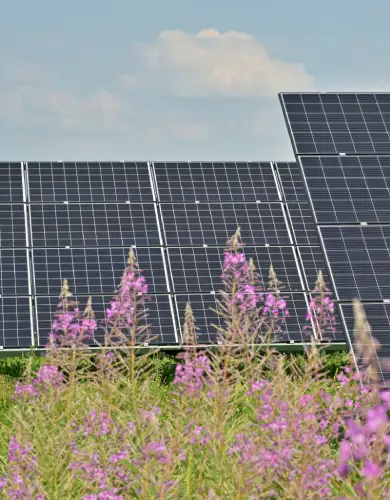What is a Photovoltaic System?
The energy transition introduces many new terms that make the topic more confusing than necessary. Whether it’s distributed grids or the utilities death spiral— we all want to be aware of the energy changes unfolding before our eyes. In this article, we’ll explore photovoltaic systems (PV Systems).
The solar panels becoming commonplace on British rooftops are only the tip of the iceberg!
Contents
- What is a Photovoltaic System?
- What are the main components of a PV system?
- What are the different types of PV Systems?
- Solar PV systems by complexity
- What are the advantages of PV system?
- What are the disadvantages of a PV system?
- The future of PV systems
- FAQs
What is a Photovoltaic System?
A photovoltaic (PV) system is any electricity system where solar PV panels are installed to generate electricity for human consumption.
This can encompass anything from a commercial agrivoltaic farm to a single solar panel providing basic smartphone charging in an off-grid mountain shelter.
Such systems can incorporate various photovoltaic and energy storage technologies, catering to various applications.
What are the main components of a PV system?
There is a clear distinction between the core and optional components of any PV system:
Core PV Components
A PV system cannot function without these components:
Solar Panels
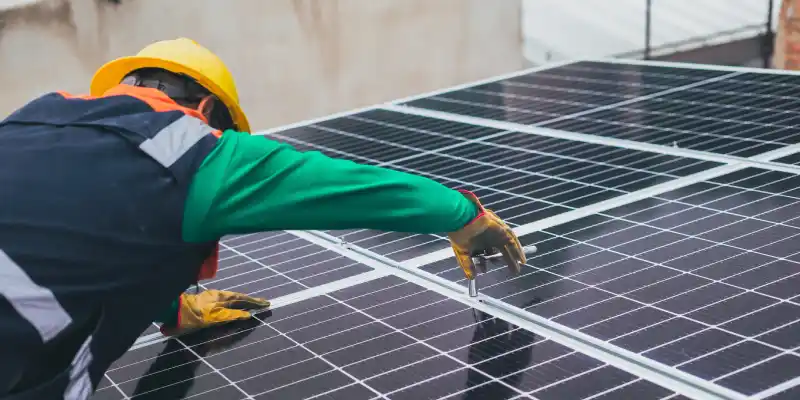
A typical solar panel comprises numerous solar cells connected in series or parallel to yield a specific voltage and current output. These cells absorb photons from sunlight, releasing electrons in the semiconductor material. Multiple solar panels can be connected to form an array, increasing the total electricity output. The size and number of panels in an array determine its total capacity– typically denoted in kilowatts (kW).
Various types of solar panels and arrays are available, as outlined below:
| Status | Cost / Lifetime kWh (£ - ££££) | |
|---|---|---|
| Monocrystalline PV | Most common | £ |
| Polycrystalline PV | Cheapest initial cost | ££ |
| Solar water heaters | Solar heating, not electricity | £ |
| Solar Thin Film | Still a niche product | ££ |
| Solar PV Roof tiles | Niche, but growing fast | £££ |
| Integrated Solar PV | Niche, but growing fast | £££ |
| PERC PV | Still a niche product | £ |
| Solar Glass | Still a niche product | ££££ |
| CPV | Not avilable yet! | n/a |
| Tandem Si-Perovskite | Available Soon! | n/a |
Extended Reading:
Solar Inverter
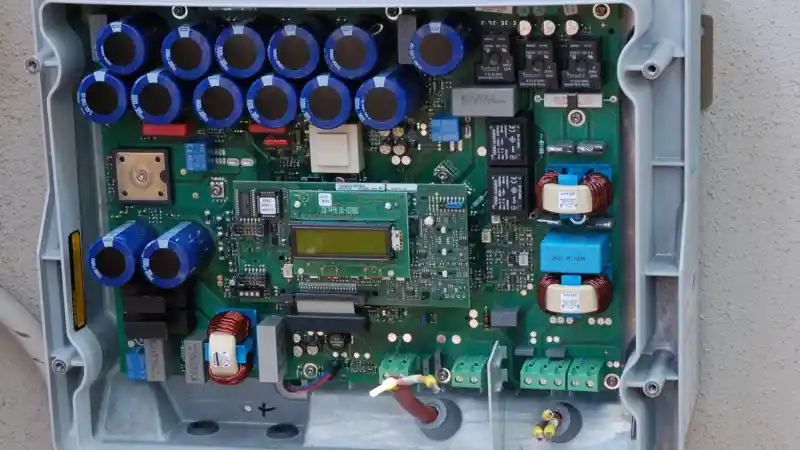
Since solar panels and solar batteries generate/store DC electricity, and most electrical appliances use alternating current (AC), an inverter is necessary to convert the DC output of the solar panels and/or batteries into AC. Without an inverter, the solar power produced would remain in DC, rendering it unusable for most applications!
There are four different types of inverters designed for solar PV systems:
| Description | Relative CAPEX (£ - £££) | |
|---|---|---|
| String Inverters (1-way) | Panels (DC) -> Mains (AC) | £ |
| Microinverters (1-way) | Each Panel (DC) -> Mains (AC) | £££ |
| Battery Inverters (2-way) | Battery (DC) <-> Mains (AC) | ££ |
| Hybrid Inverters (2-way) | Panels + Battery (DC) <-> Mains (AC) | £££ |
Mounting System
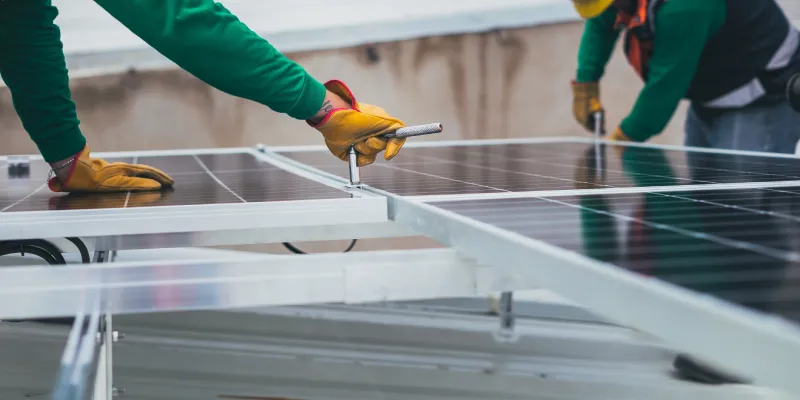
This structural framework is used to fixate and orientate solar panels to capture sunlight optimally. Panels can be affixed to rooftops, ground mounts, or tracking systems that trace the sun’s trajectory.
Here’s a list of typical solar panel mounting systems and their relative costs:
| Description | Relative cost (£ - £££) | |
|---|---|---|
| Roof-mounted | Most common. Attached directly to rooftops | £ |
| Ground-mounted | Installed on the ground; useful for larger systems or unsuitable roofs. | ££ |
| Tracking system | Pivot panels to follow the sun, maximising energy capture. | £££ |
Extended Reading:
Balance of System (BOS)
This refers to other essential components like wiring, connectors, junction boxes, fuses, switches, etc, that are needed to ensure functionality and safety.
Optional PV Components
Battery Storage
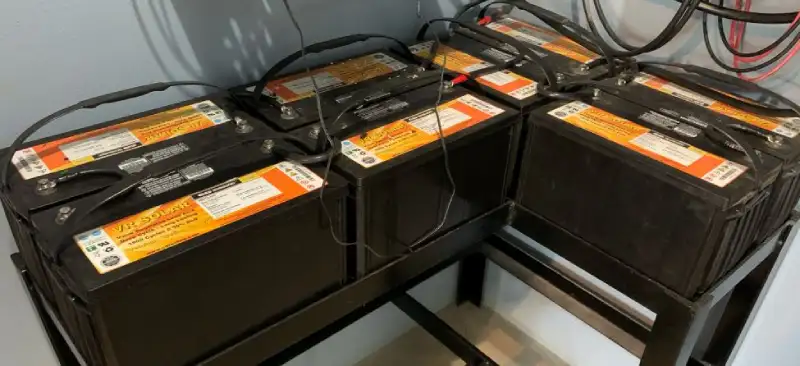
While not strictly necessary, many PV systems now incorporate battery storage to store excess electricity generated during the day. This retained overflow can be used at nighttime or during a power shortfall due to reduced production (e.g. a very rainy day). Batteries play a pivotal role in effective electricity arbitrage strategies and off-grid business energy.
Below is a summary of existing solar PV battery technologies:
| Description | Relative CAPEX (£ - £££) | |
|---|---|---|
| LiFePo Li-Ion | Safest, most durable battery. | £££ |
| NMC Li-Ion | Most established and highest energy density | ££ |
| Lead Acid | Cheapest upfront cost. Most rudimentary tech. Great for outdoors. | £ |
| Flow batteries | Not commercially available yet! | n/a |
Extended Reading:
Monitoring and Control Systems
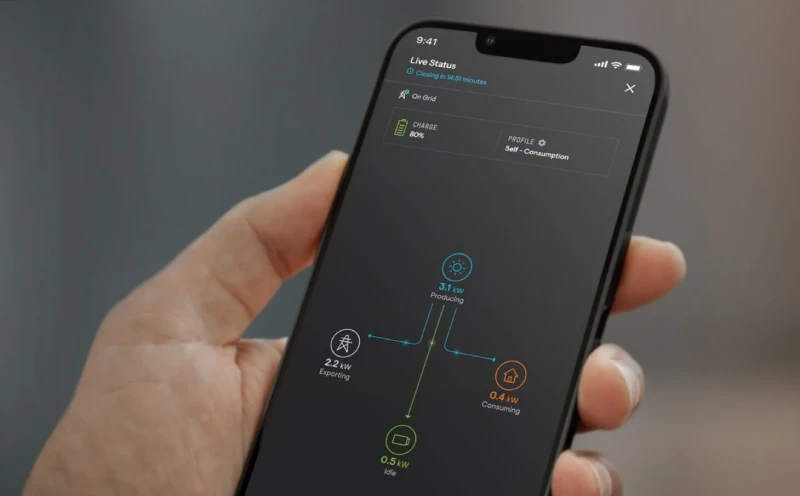
Contemporary PV systems incorporate live monitoring software and hardware that allows owners or managers to assess the real-time performance of the system. Monitoring is typically facilitated through intuitive smartphone or tablet apps that show vital statistics like electricity generation, storage and distribution while automatically storing historical data in the cloud.
Extended Reading:
Grid Connection
While not essential, most PV systems have a business energy connection with the local electricity distribution grid through export tariffs that allow excess electricity to be fed into the grid and needed power drawn from the grid during shortfall periods.
This is, however, not the case for off-grid properties that run entirely on their solar or hybrid PV systems.
Extended Reading:
- What is the national grid?
- International grid interconnectors: UK joins European grid
- The Smart Export Guarantee
What are the different types of PV Systems?
There is no single definition for a ‘type’ of PV system because there are many valuable ways of categorising one, depending on what needs to be discerned.
Here is a list of type categories we will cover in this article:
- By property type (i.e. commercial, residential, public, agricultural, etc),
- By capacity size (i.e. utility-scale, house-scale),
- By grid connectivity (i.e. grid-tied or off-grid),
- By portability (i.e. static or portable),
- By sophistication (i.e. panels only, panels + battery, etc),
Solar PV systems by property type
In the UK, the tariffs, business energy contracts, agreements, financing options, and other specifics related to your solar PV system vary significantly based on the type of property on which the system is installed.
Residential PV systems
Any system installed on a residential property, be it a cottage, semi-detached house, apartment building, etc. While panels are typically mounted on rooftops, they can technically be placed anywhere with ample sunlight exposure.
Residential systems tend to be the smallest in scale, aiming to reduce grid dependency through peak shaving, load shifting, or even transitioning to an entirely off-grid setup.
Contemporary residential systems typically incorporate Li-Ion batteries and interact with the grid via an SEG tariff, with many adding an EV charging unit as they simultaneously transition on the roads.
There is, however, no set upper limit. A large communal residential property can technically apply for a Corporate PPA if they have a large enough installation to warrant the overhead.
Commercial PV systems
A commercial solar system is typically larger than a residential one as it may have to support properties with a lot of staff (working predominantly during daylight hours) and energy-intensive appliances. They may range from small office rooftop installations to large solar arrays on warehouses or larger buildings.
As with residential properties, small systems can benefit from a grid connection via an SEG tariff, while larger systems can apply for a PPA.
Large businesses often incorporate multiple EV charging stations and might derive more value from leasing agreements than residential properties. Moreover, businesses can offset the initial investment costs of installations through business energy grants.
Community PV systems
These are often collaborative projects funded by community stakeholders (residents, small business owners, churches, local government) to install solar panel systems on favourable public or community property such as the town hall, village church, or mosque.
Such projects can draw funding from unique community-focused mechanisms like ‘community shares’ and may be supported by the government through grants and funding from:
- Rural Community Energy Fund (England; Closed in 2019)
- Urban Community Energy Fund (England; Closed in 2019)
- CARES (Scotland; Ongoing)
- Ynni Cymru (Wales)
- NGOs
- Other local and regional bodies
Solar PV systems by size
The size of a solar PV system significantly influences its intended use, financing mechanism, installation methods, and strategies for monetising power generation.
Micro-generation (<10 kW)
- Most rooftop home installations fall within this category, primarily for residential or small commercial applications.
- Typically uses the Smart Export Guarantee (SEG) to monetise excess power generation, which requires an MSC-certified installation.
- Personal savings or green loans are the most typical form of financing for micro-generation.
Small-scale (10 kW to 50 kW)
- Found in larger homes, apartment buildings, schools and churches (community PV) and medium-sized businesses.
- Typically uses the Smart Export Guarantee (SEG) to monetise excess power generation, although corporate PPAs are gaining traction.
- The larger capital investment favours lease agreements, although financing is not uncommon.
Medium-scale (50 kW to 250 kW)
- Suitable for larger commercial and industrial applications, like warehouses, factories, or agrivoltaic farms.
- It may be combined into a hybrid system with other renewable business energy sources like wind and biogas to reduce the need for batteries for load shifting.
- At this scale, PPAs are utilised to monetise power generation, and there are fewer off-grid projects at this scale.
Utility-scale (>250 kW)
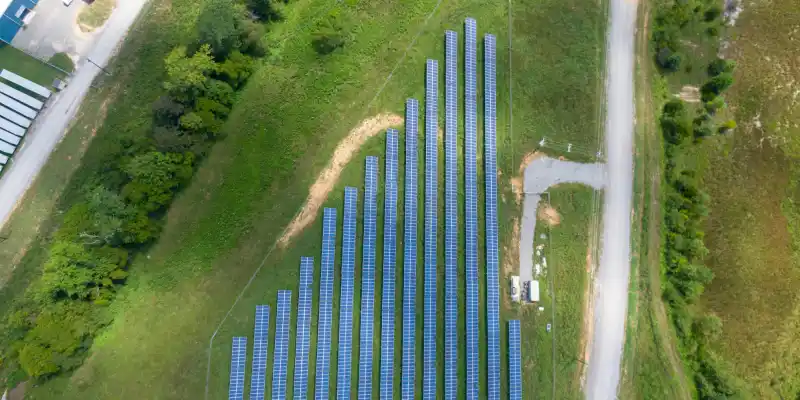
- Typically, ground-mounted solar farms or roof-mounted on exceptionally large installations.
- Projects of this size participate in CfD auctions to secure a stable income and also benefit from generating REGOs.
- Utility-scale projects often require more rigorous planning permissions and might be subject to different regulations and impact assessments.
- Different types of energy storage technologies may be considered at this scale, such as PSH, CAES, gravity, etc.
Solar PV systems by Grid-Connectivity
Grid-Tied Solar
This refers to any solar PV system connected to a larger electricity grid, presenting an opportunity to monetise excess power generation or draw electricity during shortfalls to guarantee a stable power supply.
Grid connections enable various electricity arbitrage strategies and access to mechanisms like Demand Flexibility Services.
This improved resilience comes at the cost of a business energy standing charge for this privilege, even if it does not consume any grid electricity.
Off-grid Solar
This refers to any solar PV system disconnected from any larger electricity grid, operating entirely independently. This provides immunity from external disturbances like energy crises.
When paired with a battery and generator, these systems provide reliable electricity anywhere globally, irrespective of location remoteness. In combination with satellite internet providers like Starlink and OneWeb, off-grid businesses are becoming viable.
The downside to this is that its resilience hinges on the robustness of its components: A single failure can disrupt the entire system. Hybrid systems incorporating micro run-of-the-river hydropower or alternative wind devices like Vortex and AWEs can make it more resilient.
Additionally, excess electricity can be monetised without a grid connection by using excess to keep solar-powered greenhouses warm.
Solar PV systems by portability
While most Solar PV systems are designed to remain static, there is also a portable alternative:
Portable Solar PV
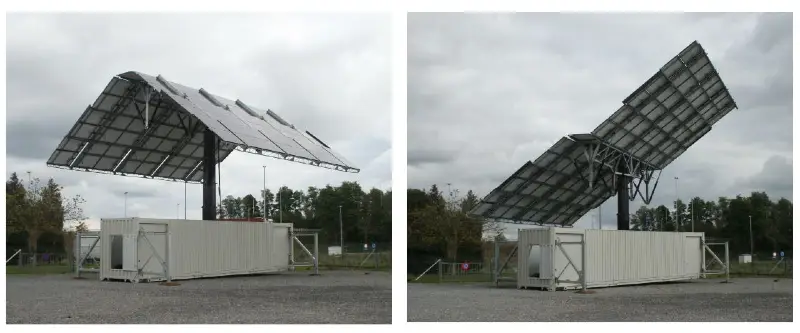
Emerging as a novel solution, portable solar PV systems aim to present a low-carbon alternative to the largely monopolised diesel generator market in portable energy.
These innovative systems are hosted in standardised shipping containers, making them easily transportable wherever required. Such containerised setups combine both panels and solar PV battery storage, affording the flexibility of relocating the system based on needs.
Extended Reading:
Solar PV systems by sophistication
The modular nature of solar technologies means that they can be made to various degrees of sophistication, depending on the use case. Here are some examples, going from simplest to most sophisticated.
Simplest: Reducing daytime grid consumption
This simple system uses solar panels to reduce the amount of electricity drawn from the grid during daylight hours by using solar power instead.
- Components: Solar panels + one-way string inverter.
- Considerations: Manual adjustment of consumption habits (like using energy-intensive appliances during the day) can increase the benefits of such systems.
Simple: Grid Export Capabilities
Building upon the most straightforward system, this configuration offsets grid consumption and feeds excess energy back to the grid via an export tariff.
- Components: Solar panels + one-way string inverter + bi-directional meter (tracks the electricity fed back into the grid).
- Considerations: There are multiple types of export tariffs available for consideration.
Standard: Peak Shaving + Export
This system incorporates energy storage (i.e. a PV Solar battery system) to save excess solar power for use during periods of higher demand or lower/no solar production, like at night or during cloudy days.
- Components: Solar panels + solar batteries + hybrid inverter (with charge controller) + bi-directional meter + monitoring system
- Considerations: This system offers the potential for electricity arbitrage, where electricity is stored when cheap and used (or sold back) when it’s more expensive. This strategy can optimise savings or profits.
Advanced: Energy Independence
Designed for complete energy self-sufficiency, these systems combine larger solar arrays with substantial battery storage and an emergency generator to minimise or eliminate grid reliance.
- Components: Solar panels + solar batteries + hybrid inverter(s) (with charge controller) + bi-directional meter + monitoring system + power generator
- Considerations: Such systems are especially valuable in remote locations or where grid reliability is an issue.
💡 There are niche solutions when these generic approaches fail. For example, solar PV roof tiles can be installed on irregular roofs or on listed buildings.
What are the pros and cons of Photovoltaic Systems?
We cover the pros and cons of solar energy in our solar energy in-depth article. Here is a summary:
Advantages of PV systems:
✅ Environmental Friendliness: Being a renewable, low-carbon, green energy source, PV systems are aligned with the UK’s climate commitments.
✅ Scalable: PV systems are modular, so they can quickly scale up or down by adjusting the number of incorporated modules.
✅ Off-grid Utility: Its reliance on sunlight means it can be installed anywhere, so it is perfect for remote use and niche applications like telecom towers and mountain shelters.
✅ Cheap: Solar PV is the cheapest form of power generation throughout its lifetime, according to LCOEs and CfDs.
✅ Upside: New solar tech like Perovskite cells promises reduced cost and novel utility.
✅ Low Maintenance: With minimal moving parts, PV systems require little solar maintenance.
✅ Increases Property Value: Solar PV systems are considered an infrastructure asset that reduces bills: it has value!
✅ Energy Independence: By reducing or eliminating reliance on the grid, solar PV systems are excellent protection or hedge against rising business electricity prices.
Disadvantages of PV Systems:
❌ Intermittancy: Without a battery, PV systems rely on other generators or grid for a stable electricity supply.
❌ Battery concerns: The popular Li-Ion batteries have an environmental dark side and may be vulnerable to supply chain issues.
❌ Some Emissions: The production of solar cells is energy-intensive.
❌ Limited Efficiency: Current PV cells are low efficiency, hovering between 10% – 20%. This translates to large space requirements (low energy density)
❌ High CAPEX: While long-term savings are evident, the immediate capital expenditure or financing for installation can be substantial.
❌ Payback Period: The payback period is hard to estimate and tends to be at least a decade.
What’s the future of Photovoltaic Systems?
We don’t have a crystal ball, but there are clearly a lot of positive takeaways from the current state of solar PV systems and their potential for the future:
Cheap, low-carbon electricity
The world will become carbon neutral by 2050, requiring the roll-out of low-carbon energy.
Not only is solar PV currently the cheapest form of renewable energy, but it is one with the most promising future, given ongoing developments in the processing, manufacturing and distribution of all of its components.
These two are significant catalysts for continued growth.
Extended Reading:
A changing world needs solar
Like other business renewable energy, installed solar power capacity is entirely independent of externalities like the global economy and geopolitics. The sun shines irrespective of any ongoing wars, pandemics or economic crises.
Adding renewables makes any energy system (no matter how big or small) resilient and independent– this is a key attribute in a world that is becoming more uncertain due to worsening climate change, AI, a changing world order, etc.
Extended Reading:
- Solar-powered seawater greenhouses: Food production in the desert
- Baseload 24/7 solar power from space
New technologies
Solar PV systems have come leaps and bounds since their commercial inception in the 70s. Nonetheless, new technologies may offer further upgrades to an already trailblazing technology. Here are some developments to support this argument:
- Will Perovskite cells spark a solar revolution?
- Flow batteries: Scalable, clean and cheap:
- 7 innovative solar technologies for the future
Grid adaptations
There are very few reasons to be cautious about the rise of solar power. Something miraculous, like the development of fusion energy, would ultimately make any other source obsolete. Still, a more realistic one is the lack of resolution from governments to adapt their infrastructure to accommodate solar power.
In the UK, the national grid is making progress. Still, it lacks essential renewable support in the form of large-scale energy storage, local energy management systems and streamlined bureaucracy to avoid things like the ongoing gridlock in the grid.
Extended Reading:
- Can Scotland become a mega battery for the whole of Europe?
- The TEC Amnesty: An attempt to connect more renewables
- A Guide to Compressed-Air Energy Storage
Smart Meters and suppliers
The roll-out of smart meters for businesses is key to the growth of Solar PV Systems. It enables business energy suppliers and home energy suppliers to offer export tariffs that cannot be offered with an older analogue meter.
Unfortunately, the UK is still rolling out smart meters, preventing more suppliers from offering export tariffs.
Extended Reading:
FAQs
What’s the history of Photovoltaic Systems?
The concept of converting sunlight into electricity has its roots in the 19th century. In 1839, a French physicist named Edmond Becquerel discovered the photovoltaic effect while experimenting with an electrolytic cell.
However, it wasn’t until 1954 that the first practical silicon solar cell was developed by Bell Labs in the U.S. This groundbreaking discovery marked the dawn of modern photovoltaic systems.
Initially, their high cost confined their use to space applications, powering satellites. Over time, technological advancements made solar cells more efficient and affordable, paving the way for their widespread terrestrial use by the late 20th century.
For a more in-depth history, see our blog on “Will Perovskite spark a solar revolution“.
How many properties in the UK have a solar PV system?
More than a million properties in the UK are equipped with solar panels on their rooftops, accounting for one-third of the nation’s total solar power capacity.
This surge in adoption was primarily during the heyday of the Feed-in-Tariff scheme. The growth is now picking up pace, thanks to the falling costs of solar PV systems and the rising wholesale energy prices.
How effective are Solar PV systems in the UK?
Solar PV panels in the UK have a capacity factor of around 10%. This means they produce, on average, about one-tenth of the power they could if the sun were shining brightly 24/7.
This performance is comparable to countries like Germany and the Netherlands. Surprisingly to many, this efficiency is not significantly lower than in sunnier countries such as Spain (14-20%), Italy (13-18%), and Greece (18-22%).
As more solar PV batteries are installed in these systems, this number decreases in relevance!
Can you combine solar PV and wind in an energy system?
Yes, you can combine solar PV and wind energy and make a hybrid energy system.
Combining them can enhance the reliability of energy supply, as the two sources often complement each other—solar panels generate more electricity on sunny days while UK wind farms produce more power during windy conditions, often at night.
Storage solutions like batteries can further optimise the system, ensuring power availability even when neither source generates electricity. Hybrid systems are particularly beneficial for off-grid applications.
